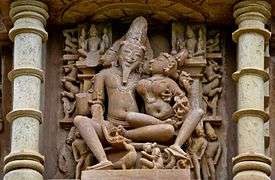Chitragupta temple, Khajuraho
| Chitragupta temple | |
|---|---|
| चित्रगुप्त मन्दिर | |
 | |
 Location in Madhya Pradesh, India  Chitragupta temple, Khajuraho (India) | |
| Basic information | |
| Location | Khajuraho |
| Geographic coordinates | 24°51′16″N 79°55′12″E / 24.8544234°N 79.9200664°ECoordinates: 24°51′16″N 79°55′12″E / 24.8544234°N 79.9200664°E |
| Affiliation | Hinduism |
| Deity | Surya |
| District | Chhatarpur |
| State | Madhya Pradesh |
| Country | India |
| Date established | 11th century CE |
The Chitragupta temple is an 11th-century temple of Surya (sun god) in the Khajuraho town of Madhya Pradesh, India. Architecturally, it is very similar to the nearby Jagadambi temple.
History
Based on the epigraphic evidence, the construction of the temple can be dated to 1020-1025 CE. It was probably consecrated on 23 February 1023 CE, on the occasion of Shivaratri.[1]
The temple has been classified as a Monument of National Importance by the Archaeological Survey of India.[2]
Architecture
The Chitragupta temple is very similar to the nearby Jagadambi temple. It has a sanctum with a circumambulatory path, a vestibule, a maha-mandapa (large hall) with transepts, and an entrance porch. The large hall has an octagonal ceiling, which is more ornate than the corresponding ceiling in the Jagadambi temple. This suggests that the Chitragupta temple was constructed slightly later than the Jagadambi temple.[3] The building has two balconies, and the ascending scale of the roof is not as impressive as that of the larger temples in Khajuraho.[4]
Sculptures
The temple's sanctum has a partially broken 2.1 metres (6.9 ft) tall statue of Surya riding a chariot of seven horses. He is shown standing, dressed in an armoured coat and boots, and holding lotus flowers. The door lintel of the sanctum also features three similar, but smaller, images of Surya.[5][3]
The exterior walls of the temple are covered with erotic couples, surasundari, and various gods, including an 11-headed Vishnu.[3] The Vishnu sculpture shows the god in his para rupa (supreme form) with his 10 incarnations: this rare representation is not seen anywhere else, and does not find a mention in any historical text.[6] Other sculptures include figures of couples engaged in mithuna, and the apsaras showing their yoni by holding their garments lower.[5] There is also a sculpture of Shiva's attendant Nandi, who is shown with a human body and a bull's head.[7]
These sculptures (and those in the Jagadambi temple) can be dated after the Vishvanatha sculptures, and before the Kandariya Mahadeva sculptures.[3]
 Exterior sculptures
Exterior sculptures Mithuna couple
Mithuna couple Apsara (right) exposes her yoni
Apsara (right) exposes her yoni Apsara (right) exposes her yoni
Apsara (right) exposes her yoni Brahma and his consort
Brahma and his consort
References
- ↑ Rana P. B. Singh 2009, p. 58.
- ↑ ASI MP List 2016.
- 1 2 3 4 ASI Bhopal Chitragupta 2016.
- ↑ Margaret Prosser Allen 1991, p. 210.
- 1 2 Ali Javid & Tabassum Javeed 2008, p. 207.
- ↑ Deepak Kannal 1995, p. 112.
- ↑ Margaret Prosser Allen 1991, p. 211.
Bibliography
| Wikimedia Commons has media related to Chitragupta Temple Khajuraho. |
- Ali Javid; Tabassum Javeed (2008). World Heritage Monuments and Related Edifices in India. Algora. ISBN 978-0-87586-482-2.
- "Chitragupta Temple". Archaeological Survey of India, Bhopal Circle. Retrieved 2016-11-16.
- "Alphabetical List of Monuments - Madhya Pradesh". Archaeological Survey of India, Bhopal Circle. Retrieved 2016-11-16.
- Deepak Kannal (1995). "Khajuraho: beginning of new iconological cycle". In R. T. Vyas. Studies in Jaina Art and Iconography and Allied Subjects. Abhinav Publications. ISBN 978-81-7017-316-8.
- Margaret Prosser Allen (1991). Ornament in Indian Architecture. University of Delaware Press. ISBN 978-0-87413-399-8.
- Rana P. B. Singh (2009). Cosmic Order and Cultural Astronomy. Cambridge Scholars. ISBN 9781443816076.
-